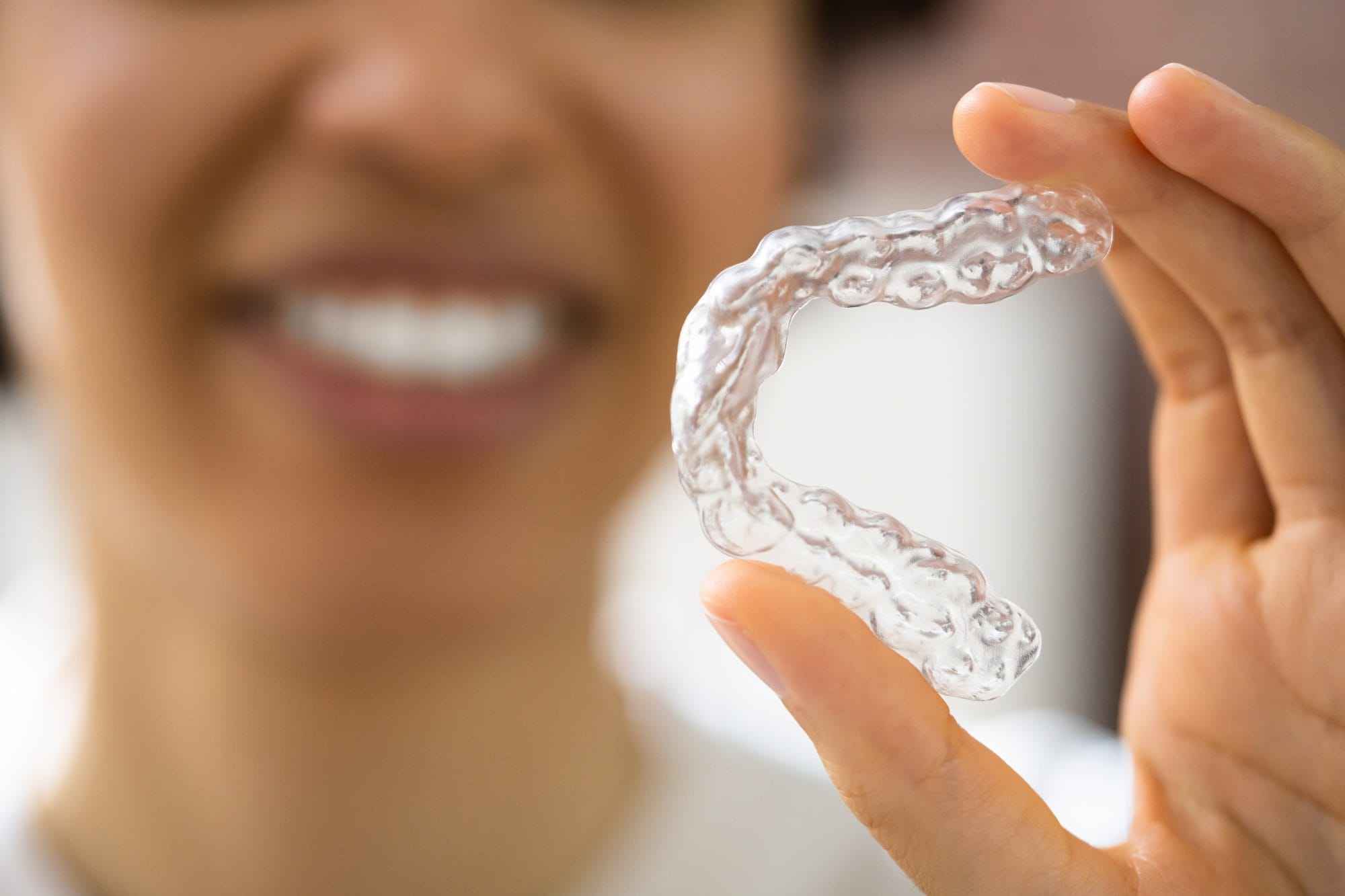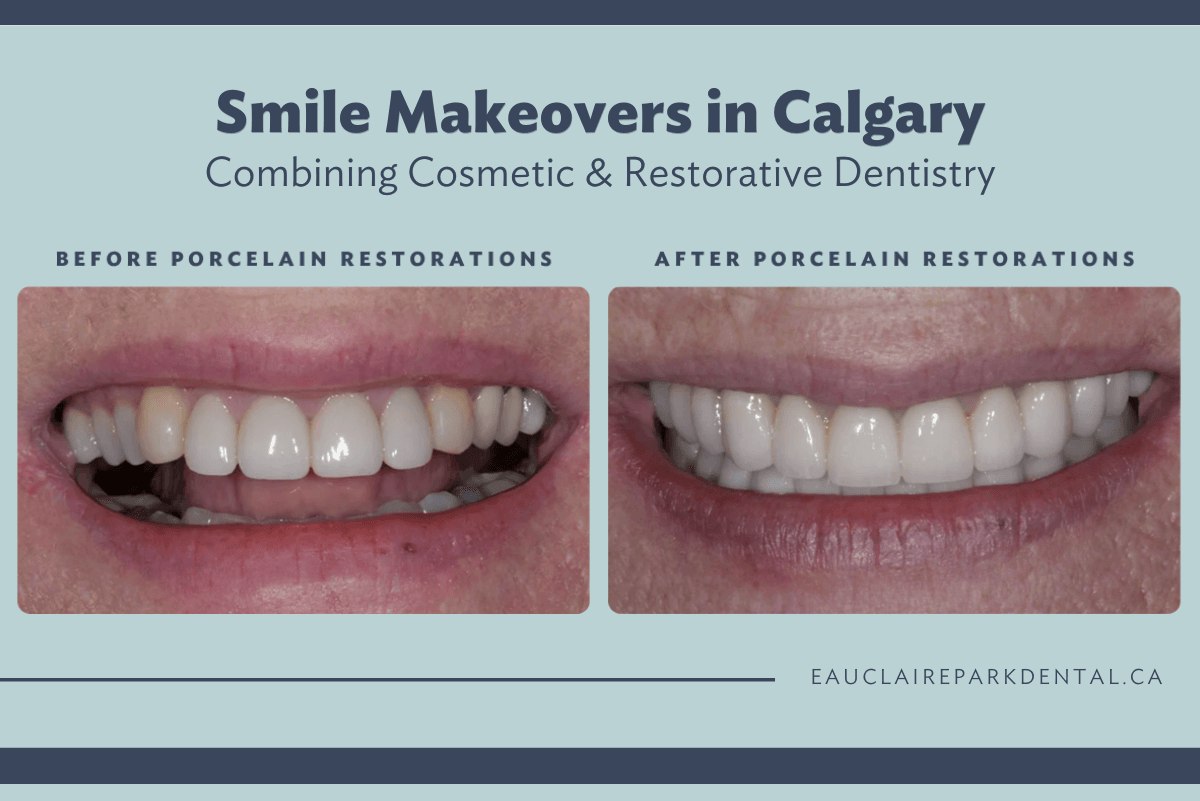You’ve invested time and money into achieving your perfect smile. Now it’s time to protect it. Whether you’re maintaining results from Invisalign treatment or preventing teeth from shifting naturally over time, proper retainer care is essential.
Knowing how to clean dental retainers properly isn’t just about hygiene—it’s about protecting your orthodontic investment and maintaining optimal oral health.
This comprehensive guide covers everything you need to know about cleaning dental retainers, from daily maintenance to in-office disinfection—keeping your retainer fresh, clean, and functioning properly.

Key Takeaways—Essential Retainer Cleaning Tips
- Keeping your retainer clean is just as important as brushing your teeth!
- Clean your retainer daily after brushing your teeth to prevent bacteria buildup.
- Use cold or warm water only. Hot water can warp plastic retainers.
- Deep clean weekly with gentle solutions like baking soda, vinegar, or specialized ultrasonic cleansers.
- Store your dental retainers properly in a ventilated case when not in use.
- Different retainer types (clear, Hawley, and permanent) require specific cleaning approaches.
Why Your Dental Retainer Needs Daily Cleaning
Retainers are custom-made appliances designed to maintain the position of your teeth after orthodontic treatment or prevent natural shifting as you age. Whether you completed traditional braces or Invisalign or simply need preventive support, your retainer works hard to protect your smile investment.
However, retainers create the perfect environment for bacteria growth. The warm, moist space between your retainer and teeth allows harmful bacteria to multiply rapidly. Without proper cleaning, this can lead to:
🔴 Bad breath (halitosis) from bacterial buildup
🔴 Increased cavity risk as bacteria produce acids that attack tooth enamel
🔴 Gum inflammation and disease from prolonged bacteria exposure
🔴 Unpleasant taste and odour that makes wearing your retainer uncomfortable
🔴 Premature retainer damage requiring costly replacement
🔴 Cloudiness and discolouration that affect the appearance of clear retainers
Proper retainer cleaning takes just a few minutes daily and can save you from expensive replacements and oral health complications.
Types of Retainers and Their Specific Cleaning Needs
Different retainer types require slightly different cleaning approaches.
Clear Plastic Retainers (Essix/Vivera)
The most common type, including Invisalign retainers and similar clear plastic appliances.
Material: Thermoplastic
Durability: 1-3 years with proper care
Best cleaning approach: Baking soda or specialized ultrasonic cleaner
Cleaning considerations:
- Most sensitive to heat and abrasives
- Most susceptible to cloudiness from improper cleaning
- Show stains and buildup more visibly
- Require gentlest cleaning methods
- Benefit most from professional in-office airflow cleaning
As an Invisalign provider, we help patients transition from active treatment to retention phase. Vivera retainers (Invisalign's retainer product) require the same gentle care as your aligners did.

Clear Plastic Retainer
Hawley Retainers (Wire and Acrylic)
Traditional retainers with metal wires and coloured acrylic plates.
Material: Acrylic and metal wire
Durability: 5-10 years with proper care
Best cleaning approach: Soft toothbrush with mild soap, avoiding abrasive scrubbing on wires.
Cleaning considerations:
- More durable than clear retainers
- Wire/acrylic junction accumulates bacteria
- Can withstand slightly firmer brushing
- Metal components need special care

Hawley Retainer
Permanent/Bonded Retainers
Fixed wires bonded to the back of teeth.
Material: Metal wire bonded with dental cement
Durability: Can last 10+ years
Best cleaning approach: Floss threaders, water flossers, and interdental brushes for daily care
Cleaning considerations:
- Requires specialized flossing techniques and regular professional monitoring.
- Use floss threaders or specialized orthodontic floss.
- Water flossers (like Waterpik) work great for bonded retainers.
- Brush thoroughly around and behind the wire or bar.
- Use interdental brushes for hard-to-reach areas.
Note: Regular dental cleanings become even more critical with permanent retainers, as professional instruments can access areas impossible to reach at home.

Fixed Wire Retainer
Signs Your Retainer Needs Immediate Cleaning
Now that you understand your retainer type, let's discuss when immediate cleaning becomes critical. You shouldn't wait for obvious problems before cleaning your retainer. However, these warning signs indicate you need to clean your dental retainers immediately:
Visual Signs:
- Cloudy or hazy appearance (clear retainers should be transparent)
- Visible film coating the surface
- White chalky deposits (mineral buildup from saliva)
- Yellowing or discolouration
- Visible food particles or debris
Sensory Signs:
- Unpleasant taste when inserting the retainer
- Bad odour even after rinsing
- Rough or gritty texture
- Sticky residue
Physical Signs:
- Difficulty inserting the retainer (buildup affecting fit)
- Irritation or inflammation of gums after wearing
- Increased tooth sensitivity
- Development of new cavities despite good brushing habits
Important: Retainers are meant to support your oral health journey. If you've noticed that you're getting more cavities, experiencing tooth sensitivity, or having other oral health problems since starting to wear your retainer, talk to your dentist to ensure it fits properly and isn't causing unintended issues.
If your retainer shows cracks, warping, or significant damage, don't attempt DIY repairs. Contact your dentist immediately, as damaged retainers can harm your teeth or become ineffective at maintaining alignment.
Dentist-Recommended Daily Retainer Routine
Build retainer cleaning into your daily brushing routine—it only takes an extra couple of minutes.
After Each Meal (If Wearing Full-Time)
- Remove your retainer carefully using proper technique
- Rinse immediately under warm running water
- Gently brush with a soft-bristled toothbrush and non-abrasive toothpaste
- Inspect for debris in grooves or hard-to-reach areas
- Use a cotton swab if needed for tight spaces
- Rinse again thoroughly before reinserting
Morning and Evening (Minimum Daily Care)
When removing your retainer:
- Rinse immediately with warm water
- Gently brush all surfaces with an electric toothbrush
- Use only water or mild, clear dish soap (like Dawn)
- Pay special attention to grooves where bacteria hide
- Rinse thoroughly to remove any soap residue
Before reinserting your retainer:
- Brush and floss your teeth thoroughly
- Ensure both teeth and retainer are completely clean
- Check retainer for any damage or buildup
- Insert only when your mouth is clean
Tip: Never use hot water on plastic retainers. Heat causes warping that makes the retainer ineffective and uncomfortable.
Weekly Deep Cleaning Methods: How to Clean Retainers Thoroughly
While daily rinsing prevents most buildup, weekly deep cleaning removes stubborn deposits and keeps your retainer fresh. Choose the method that works best for your retainer type and lifestyle.
Method 1: Baking Soda Solution (Most Recommended)
Baking soda is a gentle, natural antibacterial agent that neutralizes odours, removes stains, and won't damage your retainer.
Frequency: Once weekly, or twice weekly for heavy buildup
How to clean dental retainers with baking soda:
- Create a paste: Mix equal parts baking soda and warm water (a mud consistency is recommended)
- Apply to retainer: Use a soft-bristled toothbrush to gently scrub all surfaces
- Focus on problem areas: Pay extra attention to grooves and edges
- Soak if needed: For stubborn buildup, let paste sit for 5-10 minutes
- Rinse thoroughly: Ensure all baking soda is removed before wearing
Method 2: White Vinegar Soak
White vinegar's acidity dissolves mineral deposits and eliminates bacteria without harsh chemicals.
Frequency: Once weekly maximum (acidic solutions can weaken plastic over time)
How do you clean retainers with vinegar?
- Prepare solution: Mix 1 part white vinegar with 1 part warm water
- Submerge retainer: Soak for 15-20 minutes (no longer)
- Brush gently: Use a soft toothbrush to remove loosened deposits
- Second soak: Place in fresh warm water for 20 minutes
- Final rinse: Thoroughly rinse to remove vinegar taste/smell
Important: Vinegar has a strong odour. Consider doing this in a well-ventilated area. The smell dissipates completely after proper rinsing.
Method 3: Specialized Ultrasonic Cleaners
Ultrasonic cleaners use high-frequency sound waves to create microscopic bubbles that gently remove debris and bacteria from hard-to-reach areas of your retainer.
Frequency: Follow product instructions (usually 1-3 times weekly)
Recommended cleaning devices:
Ultrasonic retainer cleaners are available on Amazon or can be brought to our office for professional cleaning during your hygiene appointments.
How to use ultrasonic cleaners:
- Fill the cleaning tank with water (follow device instructions)
- Place retainer in the basket
- Run the cleaning cycle (typically 3-10 minutes)
- Remove and rinse thoroughly
- Brush gently if any residue remains
Why Dr. Graas prefers ultrasonic cleaners: Unlike some cleaning tablets that can cause yellowing or discolouration over time, ultrasonic cleaners provide effective cleaning without chemical exposure that might affect your retainer's appearance. They're particularly effective for removing stubborn buildup in grooves and hard-to-reach areas.
What NOT to Use: Common Retainer Cleaning Mistakes
Knowing what to avoid is just as important as knowing proper cleaning techniques. These common mistakes can permanently damage your retainer:
Boiling Water
- Warps plastic retainers in seconds
- Ruins the custom fit
- Damage is irreversible and requires replacement
Harsh Chemicals
- Alcohol-based mouthwash (can warp plastic)
- Abrasive cleaners or scouring agents
- Polident tablets or other denture cleaners can cause retainers to turn yellow over time
Dishwasher
- Extreme heat warps retainers
- Harsh detergents damage materials
- No orthodontic appliance should ever go in a dishwasher
Soaking in Mouthwash
- Alcohol content can damage plastic
- Coloured mouthwashes can stain clear retainers
- Not formulated for prolonged material contact
Professional Retainer Cleaning at Eau Claire Park Dental
Did you know you can bring your retainers to your dentist for deep disinfection? While regular retainer care at home is essential, professional cleaning provides a level of thoroughness impossible to achieve at home.
Airflow Cleaning System
During your regular dental cleaning appointment, bring your retainer, nightguard, or mouthguard for professional care. Our advanced airflow system:
- Removes all deposits and stains that resist home cleaning methods
- Completely disinfects your appliance with professional-grade technology
- Restores clarity to clouded clear retainers
- Identifies potential damage before it becomes a problem
- Extends appliance lifespan through proper maintenance
How it works: Our airflow technology uses a combination of air, water, and fine powder particles to gently yet thoroughly clean your retainer without causing any damage to the material.
Cost: Included as part of your regular dental cleaning appointment.
Frequency: Every 3-6 months during your routine dental cleaning and examination
Professional Inspection Benefits
During your appointment, our team also:
- Checks retainer fit and effectiveness
- Identifies signs of teeth shifting
- Assesses whether retainer replacement is needed
- Provides personalized care recommendations
- Answers questions about your specific appliance
Proper Retainer Storage and Maintenance
How you store your retainer between uses significantly impacts its cleanliness and longevity.
Daily Retainer Storage Tips
When Not in Your Mouth:
- Always use a ventilated retainer case
- Never wrap in tissue or napkins (easy to accidentally throw away)
- Avoid leaving in hot cars or direct sunlight
- Don't store in pockets or bags without a case
Case Cleaning:
- Wash your retainer case weekly with warm soapy water
- Allow to air dry completely before storing retainer
- Replace cases every 6-12 months or if damaged
Travel Considerations
When traveling with your retainer:
- Carry a travel toothbrush for post-meal cleaning
- Consider bringing a backup case
- Remember your regular cleaning schedule
Long-Term Storage
If you need to stop wearing your retainer temporarily:
- Clean thoroughly before storing
- Ensure it is completely dry to prevent mold
- Store in a ventilated case in a cool, dry place
- Don't store long-term in airtight containers
- Consult your dentist before discontinuing use
Dental Retainer Care FAQs:
How often should I clean my retainer?
Daily rinsing and gentle brushing should happen every time you remove your retainer. Deep cleaning should occur at least once weekly. Professional cleaning should happen every 3-6 months during your regular dental appointments.
How long do retainers last?
With proper care, clear plastic retainers typically last 1-3 years, Hawley retainers can last 5-10 years, and permanent bonded retainers can last 10+ years. Lifespan depends heavily on cleaning habits, wear patterns, and proper storage.
Why does my retainer smell bad even after cleaning?
Persistent odour indicates bacteria have penetrated microscopic scratches or that cleaning hasn't been thorough enough. Try the baking soda deep cleaning method and bring your retainer to your next dental appointment for professional cleaning. If odour persists, replacement may be necessary.
Can I soak my retainer overnight?
Brief soaking (15-30 minutes) is fine with appropriate solutions. However, overnight soaking isn't necessary, and prolonged exposure to some cleaning solutions may weaken or stain the plastic.
What should I do if my retainer turns yellow?
Yellowing indicates staining from food, beverages, or inadequate cleaning. Try the baking soda method for several consecutive days. Severe yellowing may require replacement.
Is it normal for my retainer to feel tight?
A slightly tight feeling after not wearing your retainer is normal and indicates your teeth have shifted slightly. However, if tightness persists or causes pain, your teeth may have shifted significantly.
Can I clean my retainer with hydrogen peroxide?
While diluted hydrogen peroxide (1 part peroxide to 1 part water) can be used occasionally, it's not recommended as a regular cleaning method. It can discolour certain retainer materials and weaken plastic over time. Stick to safer methods like baking soda or ultrasonic cleaners.
When to Replace Your Dental Retainer
Even with perfect care, retainers don't last forever. Watch for these signs that replacement is needed:
Immediate replacement required:
- Visible cracks or breaks
- Warping or loss of shape
- Retainer no longer fits properly
- Sharp edges that irritate the mouth
- Significant discolouration that doesn't improve with cleaning
Have it evaluated by your dentist soon:
- Persistent cloudiness despite professional cleaning
- Loosening fit (retainer moves when talking)
- Difficulty inserting or removing
- Persistent odour that cleaning doesn't resolve
- Visible wear patterns or thinning areas
At Eau Claire Park Dental, we ensure our cosmetic dentistry patients transition smoothly from treatment to retention and can order replacement retainers when needed. Don't wait until your retainer fails completely. Proactive care and timely replacement prevent teeth from shifting.
Protect Your Smile Investment
Keeping your retainer clean is just as important as brushing your teeth. Learning how to clean retainers properly is one of the simplest yet most important steps in maintaining your orthodontic results. Whether you completed years of orthodontic treatment or simply use a retainer to prevent natural shifting, proper care protects your investment and oral health.
The essential takeaways:
✓ Clean daily with warm water and gentle methods
✓ Deep clean weekly with baking soda
✓ Never use hot water or harsh chemicals
✓ Store properly in a ventilated case
✓ Bring to professional appointments every 6 months
✓ Replace when showing signs of wear
Dr. Graas and the team at Eau Claire Park Dental are committed to helping you maintain your beautiful smile for life. Our airflow cleaning system provides professional-level care that complements your home routine, and our team is always available to answer questions about your specific retainer care needs.
Ready for your next cleaning appointment? While the tips in this guide provide a strong foundation for retainer care, we can provide personalized recommendations based on your specific dental needs and treatment plan.
Schedule your visit today and bring your retainer for a complimentary professional cleaning and inspection.



